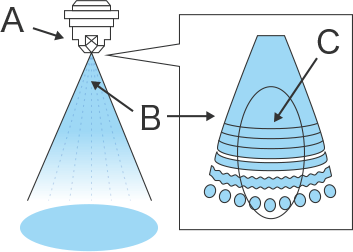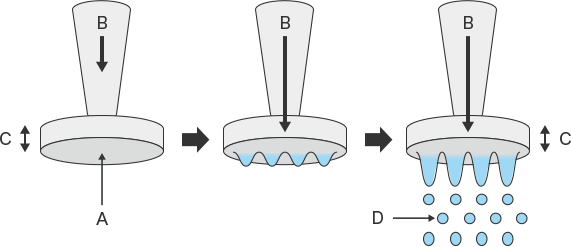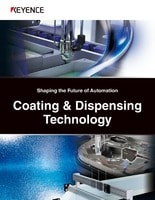Spray Coating
Overview of spray coaters
Spray coaters are devices that use atomization as the coating method. These devices turn the coating fluid into a mist and spray it onto the target.
Because of their sophisticated and diverse design, spray coaters have been used for a wide range of applications, from thin film coating of flat sheets such as transparent conductive films for touch panels, to solar cell components and semiconductor photoresist.
Spray methods
Spray coaters can be classified into three major groups according to the spray method: Air spray systems, ultrasonic spray systems, and electrostatic spray systems.
The classifications here are merely examples. There are various ways to classify the types, and some may differ from the descriptions below.
Air spray systems

- A. Nozzle
- B. Coating fluid
- C. Atomization through collision with air
Air spray systems use compressed air to change the coating fluid into a fine mist that is sprayed onto the target. A typical example is an air spray gun, which uses a similar mechanism.
Compressed air applies high pressure to the coating fluid discharged from the nozzle and the fluid then collides at a high speed with the remaining air. The coating fluid is split up and slowed down at that moment due to air resistance, and then changes into a mist before reaching the target.
Air spray systems are generally said to disperse too much coating fluid, causing relatively excessive loss of material. The equipment, however, has been designed to be sophisticated and diverse. For example, some systems use a nozzle that can change the coating fluid into a fine mist that allows uniform coating of uneven surfaces, while others can maintain high-speed spraying that enables stable coating. Other systems are capable of advanced movement control and automation of the stage and nozzle. A variety of products are available according to the target area, required efficiency, and coating purpose.
Ultrasonic spray systems

- A. Chip (atomization surface)
- B. Coating fluid
- C. Ultrasonic vibration
- D. Fine, uniform drops (atomization)
Ultrasonic spray systems are equipped with a chip (atomization surface) at the end of the nozzle. The vibration generated by ultrasonic waves causes the coating fluid to spread over the chip, and ruffling occurs on the surface. When the ultrasonic output exceeds the surface tension, the fluid drops from the surface as a fine mist.
Because these systems can create fine and uniform drops, they are suitable for uniform coating of a limited area. Another advantage is that the loss of material is considerably small because the system causes almost no splashing or unnecessary dispersion of the coating fluid.
The nozzle can be selected from many different lengths, sizes, and shapes depending on the purpose. The thickness and quality of the coating film can be controlled by setting the necessary flow and vibration frequency to ensure a uniform coating fluid spray.
Applications of these systems include insulation films and conductive films on electronic components, semiconductor photoresist, hard coating, and anti-glare, hydrophobic, and oleophobic coating.
Electrostatic spray (electrospray) systems
In electrospray systems, the coating fluid is charged with static electricity through the application of several thousands of volts in the nozzle. The fluid is then changed into a fine mist through electrostatic repulsion. The coating fluid mist is attracted to the surface of the target, which sits on a grounded stage. These systems can be used for fluids with varying viscosities as well as pastes, slurries, and fluids containing filler dispersion. The result is a uniform film of even on substrates with uneven surfaces.
Because almost all of the coating fluid can be deposited on the surface of the substrate only, the efficiency of fluid use is significantly higher than typical air spray coaters and spin coaters. This makes it possible to reduce material costs.






